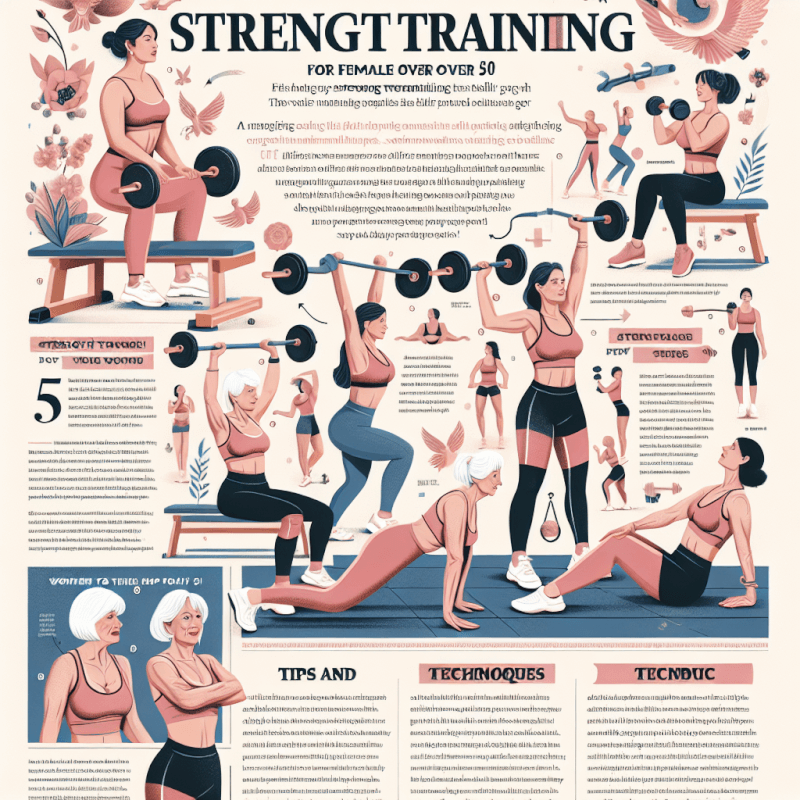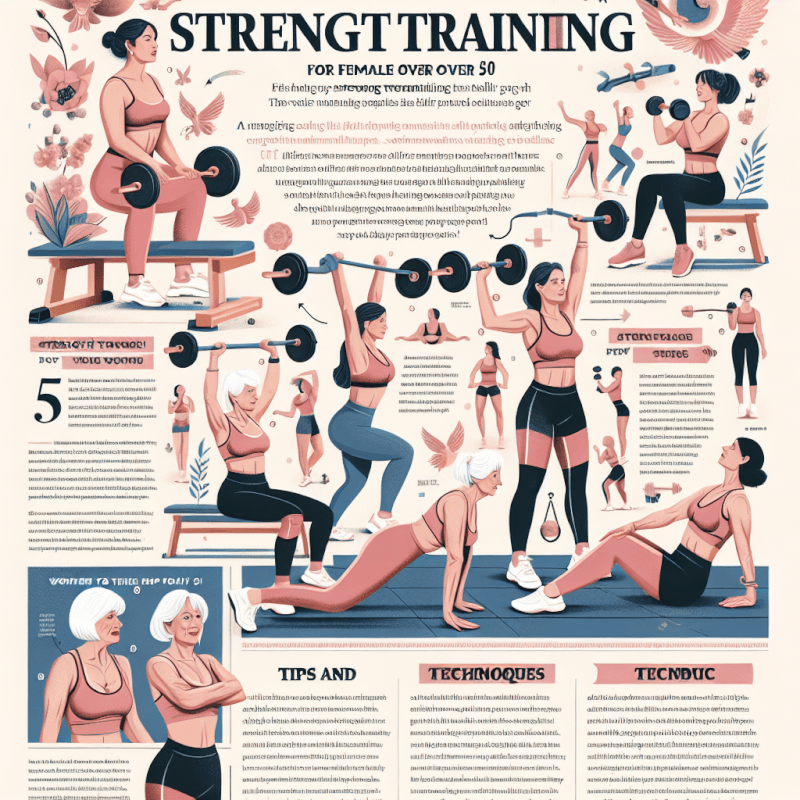Are you a woman over the age of 50 who is interested in staying active and maintaining your strength? Look no further! In this article, we will explore the benefits of strength training specifically tailored for women aged 50 and older. From improving bone density to boosting your metabolism, strength training can have a transformative effect on your overall health and well-being. So get ready to unleash your inner strength and discover how strength training can help you age gracefully and confidently.
Benefits of strength training
Increased muscle strength
Strength training is an excellent way to increase your muscle strength, especially for women over 50. As you age, muscle mass naturally declines, leading to weakness and decreased functionality. By incorporating strength training into your fitness routine, you can combat this decline and build stronger muscles. Increased muscle strength not only improves your overall physical performance but also makes day-to-day activities, such as carrying groceries or climbing stairs, much easier and less demanding.
Improved bone density
Another significant benefit of strength training for women over 50 is improved bone density. Aging can lead to a decrease in bone density, putting you at a higher risk for osteoporosis and fractures. However, engaging in regular strength training exercises can help increase bone density, thus improving your bone health and reducing the risk of osteoporosis. By adding resistance and weight-bearing exercises to your workout routine, you can strengthen your bones and maintain their density as you age.
Enhanced metabolism
Strength training is highly effective in boosting your metabolism, which is particularly beneficial for women over 50 who may experience a slower metabolism due to hormonal changes. By building lean muscle mass through strength training, you can increase your basal metabolic rate (BMR), meaning your body will burn more calories even at rest. This can aid in weight management and help prevent weight gain commonly associated with aging. Additionally, a higher metabolism can provide you with more energy throughout the day, making you feel more active and youthful.
Reduced risk of chronic diseases
Regular strength training can significantly reduce the risk of developing chronic diseases, such as heart disease, diabetes, and certain types of cancer. As you engage in strength training, you improve your cardiovascular health, decrease blood pressure, and enhance insulin sensitivity. This can contribute to a reduced risk of heart disease and diabetes, which are more prevalent in women over 50. Furthermore, strength training has been shown to lower the risk of certain types of cancer, including breast and colon cancer. By incorporating strength training into your fitness routine, you are taking proactive steps towards improving your overall health and reducing the risk of chronic diseases.
Choosing the right exercises
Consulting with a doctor or trainer
Before starting any exercise program, it is essential to consult with a doctor or certified fitness trainer, especially if you are over 50 years old. They can help assess your current health condition, identify any limitations or health concerns, and provide guidance on what exercises are safe and suitable for you. A healthcare professional can also offer valuable advice on how to modify exercises to accommodate any pre-existing injuries or conditions, ensuring a safe and effective strength training program.
Focusing on compound exercises
Compound exercises are movements that engage multiple muscle groups simultaneously. These exercises are particularly beneficial for women over 50 as they maximize efficiency and effectiveness in building muscle strength and improving overall functionality. Examples of compound exercises include squats, deadlifts, lunges, push-ups, and rows. Incorporating these exercises into your strength training routine ensures that you are targeting multiple muscle groups, leading to improved muscle coordination, increased overall strength, and enhanced balance.
Incorporating resistance training
Resistance training is a crucial component of strength training, and it involves using external weights or resistance to challenge your muscles. As a woman over 50, it is important to gradually increase the intensity of your resistance training to prevent injuries and ensure continuous progress. Start with lighter weights and gradually work your way up to heavier ones as you become more comfortable and stronger. Resistance training can be done using dumbbells, resistance bands, weight machines, or even your body weight. Including a variety of resistance exercises in your workout routine ensures that you are targeting different muscle groups and achieving a well-rounded strength training program.

Setting realistic goals
Assessing your current fitness level
Before setting any goals, it is crucial to assess your current fitness level accurately. This will help you determine where to start and provide a benchmark for tracking your progress. Assessing your fitness level can include measuring your strength, endurance, flexibility, and cardiovascular fitness. Take note of how much weight you can comfortably lift, how far you can walk or run without feeling fatigued, and how flexible your body is. By understanding where you are starting from, you can set realistic and achievable goals that will keep you motivated and focused on your strength training journey.
Identifying specific goals
To stay motivated and focused, it is important to identify specific goals that you want to achieve through strength training. For women over 50, goals can range from increasing muscle strength and endurance to improving balance and overall functionality. Whatever your goals may be, make sure they are clear, measurable, and attainable. For example, instead of setting a vague goal like “getting stronger,” you can set a specific goal such as “increasing my leg strength by 20% within three months.” This way, you can track your progress and celebrate each milestone along the way.
Creating a workout plan
Once you have assessed your current fitness level and identified your specific goals, it’s time to create a workout plan that aligns with your aspirations. Your plan should include a combination of strength and cardiovascular exercises, as both are essential for overall fitness. Aim for at least two to three strength training sessions per week, while also incorporating cardio exercises like brisk walking, cycling, or swimming on alternate days. It is important to strike a balance between challenging yourself and allowing enough time for rest and muscle recovery. Gradually increase the intensity of your workouts as you become stronger and more comfortable. Additionally, consider scheduling regular check-ins with a trainer or fitness professional to ensure that your workout plan remains effective and aligned with your goals.
Designing an effective workout plan
Including both strength and cardiovascular exercises
Designing an effective workout plan for women over 50 involves incorporating both strength and cardiovascular exercises. Strength training exercises help build muscle mass and improve overall strength, while cardiovascular exercises elevate your heart rate, improve cardiovascular health, and aid in weight management. Ideally, aim for a balance between the two types of exercises. Allocate at least two to three days per week for strength training, focusing on all major muscle groups. On the other days, engage in moderate-intensity cardiovascular exercises for a duration of 30 minutes or more. This combination of exercises ensures you are targeting different aspects of fitness and achieving a well-rounded workout plan.
Warm-up and cool-down routines
Before diving into your workout, it is important to warm up your muscles and prepare your body for the physical activity ahead. A proper warm-up routine can include dynamic stretches, light cardio exercises, or foam rolling to increase blood flow to your muscles, improve flexibility, and reduce the risk of injuries. Similarly, a cool-down routine is crucial to gradually bring your heart rate down and prevent muscle soreness. Incorporate static stretches and gentle movements in your cool-down routine to help reduce muscle tension and promote recovery. Remember that warming up and cooling down are just as important as the main workout itself and should never be neglected.
Gradually increasing intensity
As you progress in your strength training journey, it is important to gradually increase the intensity of your workouts to continue challenging your muscles and avoiding plateauing. This can be done by increasing the amount of weight you lift, adding more repetitions or sets, or reducing the rest time between exercises. However, make sure to listen to your body and avoid pushing yourself too hard too quickly. Incremental increases in intensity will help prevent injuries and allow your muscles to adapt and grow stronger over time. Consider working with a trainer or fitness professional who can guide you in safely increasing the intensity of your workouts and adjusting your program as needed.

Proper form and technique
Maintaining proper posture and alignment
One of the key factors in strength training is maintaining proper form and technique throughout your exercises. This ensures that you are effectively targeting the intended muscles and reducing the risk of injury. Focus on maintaining proper posture and alignment during every exercise, including keeping your spine neutral, shoulders relaxed, and core engaged. For example, when performing squats, ensure your knees track over your toes, your back is straight, and your weight is in your heels. Proper form not only maximizes the benefits of strength training but also helps prevent unnecessary stress on your joints and muscles.
Using lighter weights and focusing on form
When starting out or learning new exercises, it is advisable to use lighter weights and focus on mastering the proper form and technique. This allows you to build a strong foundation and ensure that you are performing the exercises correctly. Using lighter weights also reduces the risk of injury as you familiarize yourself with the movements and learn to engage the correct muscles. As you progress and become more comfortable, you can gradually increase the weight or resistance. Remember, it is better to start light and progress steadily than to rush into heavy weights without proper form.
Seeking professional guidance
If you are unsure about performing certain exercises with proper form and technique, it is highly recommended to seek professional guidance. Working with a qualified trainer or fitness professional can provide you with valuable insights and corrections to your form, ensuring that you are maximizing the benefits of your strength training workout. They can also guide you on how to progress and modify exercises based on your individual needs and limitations. Investing in proper instruction and guidance can significantly improve the effectiveness and safety of your strength training routine.
Balancing weight training and cardio
Building endurance through cardio
While strength training is crucial for building muscle strength, cardiovascular exercises play a vital role in building endurance and improving overall cardiovascular health. As you age, it becomes increasingly important to maintain good cardiovascular fitness. Engaging in regular cardiovascular exercises such as brisk walking, jogging, cycling, or swimming helps improve lung capacity, increase stamina, and boost your overall energy levels. Moreover, cardiovascular exercises contribute to weight management and can aid in reducing the risk of chronic diseases such as heart disease and diabetes. Aim to include two to three days of moderate-intensity cardio exercises in your weekly workout plan to maintain a healthy balance between strength and cardiovascular training.
Combining cardio and strength training
To get the most out of your workout routine, it is beneficial to combine both cardiovascular exercises and strength training. By doing so, you can achieve optimal results in terms of overall fitness, weight management, and muscle strength. One way to do this is by incorporating circuit training, where you alternate between strength exercises and cardiovascular activities with minimal rest in between. For example, you can perform a set of squats, followed by a minute of jumping jacks, then move on to lunges, and finally, do a set of push-ups. This combination challenge not only targets different muscle groups but also elevates your heart rate, providing an efficient full-body workout.
Ensuring rest and recovery
While both strength training and cardiovascular exercises are essential for your fitness, it is equally important to allow your body enough time to rest and recover. Rest and recovery periods are when your muscles repair and grow stronger. Overtraining or not allowing sufficient recovery time can lead to fatigue, decreased performance, and an increased risk of injuries. Make sure to schedule rest days throughout your week and listen to your body’s signals. If you are feeling excessively fatigued or experiencing muscle soreness that does not improve with rest, it may be a sign that you need more recovery time. Prioritizing rest and recovery is key to maintaining a well-balanced and sustainable fitness routine.

Safety considerations
Warming up before each workout
Before starting any strength training or cardio routine, it is vital to warm up your muscles adequately. A warm-up routine increases blood flow to your muscles, prepares them for physical activity, and reduces the risk of injuries. A dynamic warm-up that includes movements such as jogging in place, arm circles, or bodyweight squats is effective in raising your core temperature, loosening up your joints, and activating your muscles. Dedicate at least 5-10 minutes to a warm-up before each workout session to ensure your body is properly prepared.
Avoiding overexertion and injuries
Safety should always be a top priority when engaging in any exercise, especially for women over 50. To prevent overexertion and injuries, it is important to listen to your body and avoid pushing yourself too hard. Gradually progress in terms of weights, repetitions, or intensity, and avoid sudden increases that can strain your muscles or joints. It is normal to challenge yourself during a workout, but never sacrifice proper form and technique to lift heavier weights or complete more repetitions. If you experience any pain or discomfort during exercise, stop immediately and consult with a healthcare professional or trainer.
Listening to your body
Throughout your strength training journey, it is crucial to listen to your body’s signals and respond accordingly. Everyone’s fitness level and physical abilities are unique, so what may work for someone else may not be suitable for you. Pay attention to how your body feels during and after each workout session. If you feel unusually fatigued, experience persistent pain, or notice any significant changes in your body, it may be a sign that you need to modify your approach or consult with a healthcare professional. Always prioritize your safety and well-being by allowing ample rest, addressing any discomfort promptly, and making appropriate adjustments to your workout routine.
Nutrition and hydration
Eating a balanced diet
Strength training can be even more effective when combined with a nutritious and balanced diet. As a woman over 50, your body requires specific nutrients to support your overall health and fitness goals. Aim to consume a variety of whole foods, including lean proteins, fruits, vegetables, whole grains, and healthy fats. These foods provide essential vitamins, minerals, and antioxidants that promote muscle repair and growth, support bone health, and enhance overall well-being. Avoid processed and sugary foods as much as possible, as they can contribute to inflammation and hinder your progress. Remember, proper nutrition is a crucial component of any successful strength training program.
Consuming enough protein
Protein plays a vital role in muscle repair and growth, making it an essential nutrient for women over 50 engaging in strength training. Aim to consume an adequate amount of protein to support your muscle-building goals. Good sources of protein include lean meats, poultry, fish, eggs, dairy products, legumes, and plant-based options like tofu and tempeh. Additionally, consider incorporating snacks or meals containing protein both before and after your strength training sessions to optimize muscle recovery. Consult with a registered dietitian or nutritionist who can provide personalized guidance on your protein needs based on your age, weight, and specific fitness goals.
Staying hydrated
Proper hydration is often overlooked but is essential for optimal performance during strength training exercises. Women over 50 should aim to drink sufficient water throughout the day to ensure proper hydration. During exercise, your body loses water through sweat, and it is essential to replenish those fluid losses. Hydration helps maintain joint lubrication, regulate body temperature, and support overall bodily functions. As a general guideline, aim to drink at least eight 8-ounce glasses of water per day, or more if you are engaging in intense physical activity. Remember to listen to your body’s thirst signals and sip water regularly during your workout sessions.

Adapting to age-related changes
Modifying exercises for joint health
As women age, they may experience changes in joint health, including increased stiffness and decreased flexibility. To accommodate these age-related changes, it is important to modify exercises as needed to prioritize joint health. This can involve adjusting range of motion, using exercise modifications, or selecting low-impact exercises that minimize stress on the joints. For instance, if you experience knee pain, replacing high-impact exercises like running with low-impact options such as cycling or swimming can help alleviate strain on the joints. Be mindful of any discomfort or limitations and work with a trainer or healthcare professional to modify exercises accordingly.
Addressing hormonal changes
Hormonal changes, such as a decrease in estrogen levels, can affect women’s bodies as they age, contributing to changes in muscle mass, bone density, and metabolism. Strength training can be particularly beneficial in offsetting these changes. It helps build and preserve muscle mass, elevate metabolism, and support bone health. By engaging in regular strength training exercises, you can mitigate the impact of hormonal changes and maintain a healthy and active lifestyle. If you have concerns about hormonal changes or any related symptoms, consult with your healthcare provider for guidance and appropriate support.
Maintaining flexibility and mobility
Flexibility and mobility are crucial aspects of overall fitness, especially for women over 50. As you engage in regular strength training, it is important to prioritize flexibility exercises that promote joint mobility and muscle elasticity. Stretching exercises can help maintain or improve flexibility, reduce muscle tension, and improve your range of motion. Incorporate dynamic stretching before your strength training workout and static stretching during your cool-down routine. Additionally, activities such as yoga or Pilates can be beneficial in improving flexibility, balance, and core strength. Focusing on flexibility and mobility ensures that you maintain your functional abilities and reduce the risk of injuries as you age.
Finding support and motivation
Joining fitness classes or groups
Finding support and motivation is crucial in maintaining a consistent strength training routine, especially as a woman over 50. Joining fitness classes or groups can provide you with a sense of community, accountability, and encouragement. Consider participating in strength training classes specifically designed for women, or even seek out age-specific fitness groups. Exercising alongside others who share similar goals and challenges can make your fitness journey more enjoyable and rewarding. Additionally, fitness classes often have qualified instructors who can offer guidance, modify exercises, and ensure proper form, enhancing the effectiveness and safety of your workouts.
Working out with a partner
Another effective way to stay motivated and committed is to find a workout partner. Exercising with a partner not only provides encouragement and friendly competition but also creates a sense of accountability. You can challenge each other, share workout tips, and celebrate each other’s achievements. Having a workout partner can make strength training sessions more enjoyable and establish a consistent routine. Whether it’s a friend, family member, or even a virtual accountability partner, having someone by your side can make a significant difference in staying motivated and achieving your fitness goals.
Tracking progress and celebrating achievements
To stay motivated and monitor your progress, it is valuable to track your fitness journey. Keep a record of your workouts, including exercises performed, weight lifted, repetitions, and any relevant notes or observations. Tracking your progress allows you to see how far you’ve come, identify areas of improvement, and set new goals. Additionally, don’t forget to celebrate your achievements along the way. Acknowledge and reward yourself for reaching milestones or overcoming challenges. Celebrating small victories can boost your confidence, reinforce your commitment to strength training, and provide the motivation to keep pushing yourself towards continuous improvement.
In conclusion, strength training offers numerous benefits for women over 50. From increased muscle strength to improved bone density, enhanced metabolism, and a reduced risk of chronic diseases, strength training can significantly improve your overall health and well-being. By choosing the right exercises, setting realistic goals, designing an effective workout plan, focusing on proper form and technique, balancing weight training and cardio, considering safety factors, optimizing nutrition and hydration, adapting to age-related changes, and finding support and motivation, you can embark on a successful strength training journey. Remember, it is never too late to start strength training, and with dedication and consistency, you can experience the transformative benefits it offers for a healthier and more fulfilling life.


